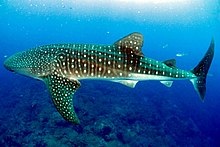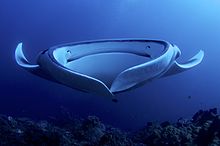Marine Megafauna Foundation
 | |
| Formation | 2009 |
|---|---|
| Founders | Andrea Marshall & Simon J Pierce |
| Founded at | Tofo Beach, Mozambique |
| Legal status | 501(c)(3) non-profit conservation organization |
| Headquarters | West Palm Beach, Florida, United States |
| Affiliations | Manta Matcher, Sharkbook (formerly Whaleshark.org), Galapagos Whaleshark Project, Byron Bay Leopard Shark Project, Madagascar Whale Shark Project |
| Website | https://www.marinemegafauna.org/ |
Formerly called | Manta Ray & Whale Shark Research Centre |
The Marine Megafauna Foundation (MMF) is a marine biology research and conservation nonprofit known for discovering, researching, and protecting large marine animals including whale sharks, manta rays, sea turtles, whales, and dugongs.


MMF has permanent research & conservation sites in Mozambique, Australia, Indonesia, and Florida, as well as other temporary locations.[1][2][3][4][5]
History
MMF was founded in 2009 by marine biologists Andrea Marshall and Simon J Pierce in Tofo Beach, Mozambique.
Discoveries, research, and conservation initiatives
- Developed new techniques to use photo identification and artificial intelligence to study and track populations of whale sharks and other marine animals.[6][7] These are incorporated in Citizen science programs such as Sharkbook[8] and Manta Matcher.[9][10][11]
- Discovered a new type of Manta, the "reef manta ray" (Manta alfredi)[12]
- Led initiatives to add whale sharks,[13] reef manta rays,[14] and oceanic manta rays[15][16] to the IUCN Red List of Threatened Species.
- Established the Inhambane Province Hope Spot in collaboration with Sylvia Earle's Mission Blue[17][18]
- Documented the first sightings of the ornate eagle ray (Aetomylaeus vespertilio) in the Bazaruto Archipelago National Park, Inhambane Province, Mozambique[19][20]
- Documented the first recorded sighting of a live Smalleye Stingray underwater in 2009 and then the first successful tag of "the World's biggest ocean stingray"[21] in 2023.
- Completed the first study of South Florida manta ray population Luu,[22] and created what was reported to be the first digital 3D manta ray model with the Digital Life Project and ANGARI Foundation.[22]
- Uncovered illegal Chinese fishing practices after a whale shark named "Hope" with a satellite tag tracked by MMF was killed in Galapagos. This incident resulted in expansion of the Marine Protected Zone around the Galapagos.[23][24][25]
- Created “Ocean Guardians” conservation education project in Mozambique recognized by UNESCO.[26]
External links
- "WATCH: Investigating the Mysterious Whale Sharks of Mafia Island" (video). youtube.com. National Geographic. Jan 24, 2017.
- "WATCH: Andrea Marshall: Queen of the Manta Rays -Nat Geo Live" (video). youtube.com. National Geographic. Jul 15, 2013.
- "WATCH: Andrea - Queen of Mantas - First Ever Encounter with Smalleye Stingray" (video). bbc.co.uk. BBC. 2009.
- "WATCH: Dr. Sylvia Earle Introduces the Inhambane Seascape Hope Spot" (video). youtube.com. Sylvia Earle. Jan 26, 2022.
References
- ^ "Manta rays form close friendships, shattering misconceptions". National Geographic. 2019-08-27. Archived from the original on April 13, 2021. Retrieved 2023-02-05.
- ^ "A wildlife first: World's biggest ocean stingray tagged in the wild". National Geographic. 2023-01-24. Archived from the original on January 24, 2023. Retrieved 2023-01-30.
- ^ Will (2019-11-20). "Marine megafauna accidentally consuming harmful microplastics in Indonesia". Oceanographic. Retrieved 2023-01-30.
- ^ "Whale sharks feeding in the western Indian Ocean - in pictures". The Guardian. 2018-08-09. ISSN 0261-3077. Retrieved 2023-01-30.
- ^ "Manta Rays and Whale Sharks Are Consuming a Staggering Amount of Plastic". Gizmodo. 2019-11-19. Retrieved 2023-01-31.
- ^ Marshall, A. D.; Pierce, S. J. (April 2012). "The use and abuse of photographic identification in sharks and rays". Journal of Fish Biology. 80 (5): 1361–1379. doi:10.1111/j.1095-8649.2012.03244.x. PMID 22497388.
- ^ Matthews-King, Alex (23 January 2017). "Whale sharks' secrets revealed by live-tracking aquatic drones". New Scientist. Retrieved 2023-01-31.
- ^ "How A.I. is helping to protect the endangered whale sharks of the Galapagos". Fortune. Retrieved 2023-01-31.
- ^ Klein, JoAnna (2019-10-14). "The Mystery of the Melanistic Manta Rays". The New York Times. ISSN 0362-4331. Retrieved 2023-02-02.
- ^ Venables, Stephanie K.; Marshall, Andrea D.; Germanov, Elitza S.; Perryman, Robert J. Y.; Tapilatu, Ricardo F.; Hendrawan, I Gede; Flam, Anna L.; van Keulen, Mike; Tomkins, Joseph L.; Kennington, W. Jason (2019-10-09). "It's not all black and white: investigating colour polymorphism in manta rays across Indo-Pacific populations". Proceedings of the Royal Society B: Biological Sciences. 286 (1912): 20191879. doi:10.1098/rspb.2019.1879. PMC 6790782. PMID 31594509.
- ^ "How A.I. is helping to protect the endangered whale sharks of the Galapagos". Fortune. Retrieved 2023-02-06.
- ^ Marshall, Andrea D.; Compagno, Leonard J. V.; Bennett, Michael B. (2009-12-31). "Redescription of the genus Manta with resurrection of Manta alfredi (Krefft, 1868) (Chondrichthyes; Myliobatoidei; Mobulidae)". Zootaxa. 2301: 1–28. doi:10.5281/zenodo.191734.
- ^ Pierce, S.J. & Norman, B. 2016. Rhincodon typus. The IUCN Red List of Threatened Species 2016: e.T19488A2365291. doi:10.2305/IUCN.UK.2016-1.RLTS.T19488A2365291.en. Accessed on 31 January 2023.
- ^ Marshall, A., Barreto, R., Carlson, J., Fernando, D., Fordham, S., Francis, M.P., Herman, K., Jabado, R.W., Liu, K.M., Pacoureau, N., Rigby, C.L., Romanov, E. & Sherley, R.B. 2022. Mobula alfredi (amended version of 2019 assessment). The IUCN Red List of Threatened Species 2022: e.T195459A214395983. doi:10.2305/IUCN.UK.2022-1.RLTS.T195459A214395983.en. Accessed on 31 January 2023.
- ^ Will (2020-12-10). "Giant manta becomes first manta ray to be listed as an endangered species". Oceanographic. Retrieved 2023-02-02.
- ^ Marshall, A., Barreto, R., Carlson, J., Fernando, D., Fordham, S., Francis, M.P., Derrick, D., Herman, K., Jabado, R.W., Liu, K.M., Rigby, C.L. & Romanov, E. 2022. Mobula birostris (amended version of 2020 assessment). The IUCN Red List of Threatened Species 2022: e.T198921A214397182. doi:10.2305/IUCN.UK.2022-1.RLTS.T198921A214397182.en. Accessed on 31 January 2023.
- ^ "Inhambane Seascape in Mozambique Recognized as Mission Blue Hope Spot".
- ^ "WATCH: Dr. Sylvia Earle Introduces the Inhambane Seascape Hope Spot" (video). youtube.com. Sylvia Earle. Jan 26, 2022.
- ^ "Researchers Document the Rare Ornate Eagle Ray". Marine Megafauna Foundation. Retrieved 2023-01-31.
- ^ Venables, Stephanie K.; Conradie, Janneman; Marshall, Andrea D. (November 2021). "First records of the ornate eagle ray Aetomylaeus vespertilio from the Inhambane Province, Mozambique". Journal of the Marine Biological Association of the United Kingdom. 101 (7): 1085–1088. doi:10.1017/S0025315422000054. ISSN 0025-3154. S2CID 247379157.
- ^ "A wildlife first: World's biggest ocean stingray tagged in the wild". National Geographic. 2023-01-24. Archived from the original on January 24, 2023. Retrieved 2023-01-31.
- ^ a b Steinhoff, Nane (2022-04-06). "First digital 3D model of a manta ray created". Oceanographic. Retrieved 2023-02-02.
- ^ "Galapagos marine reserve: Conservationists hail expansion". BBC News. 2021-11-03. Retrieved 2023-02-06.
- ^ Myers, Steven Lee; Chang, Agnes; Watkins, Derek; Fu, Claire (2022-09-26). "How China Targets the Global Fish Supply". The New York Times. ISSN 0362-4331. Retrieved 2023-02-06.
- ^ Collyns, Dan (2020-08-06). "'They just pull up everything!' Chinese fleet raises fears for Galápagos sea life". The Guardian. ISSN 0261-3077. Retrieved 2023-02-06.
- ^ "Ocean Guardians". Unesco Green Citizens. Retrieved 2023-02-06.
